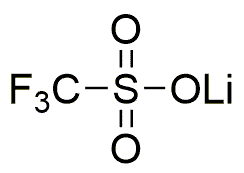Lithium trifluoromethanesulfonate is widely utilized in research focused on:
- Electrolytes in Batteries: This compound serves as an effective electrolyte in lithium-ion batteries, enhancing their performance and stability, which is crucial for electric vehicles and portable electronics.
- Chemical Synthesis: It acts as a versatile reagent in organic synthesis, facilitating the formation of various chemical bonds, making it valuable in pharmaceuticals and agrochemicals.
- Conductive Polymers: Used in the development of conductive polymers, it improves the conductivity and overall performance of materials used in electronic devices.
- Corrosion Inhibitors: This compound is employed in coatings to prevent corrosion in metals, particularly in the automotive and aerospace industries, where durability is essential.
- Research in Ionic Liquids: It plays a significant role in the formulation of ionic liquids, which are used in green chemistry applications, providing environmentally friendly alternatives to traditional solvents.
General Information
Properties
Safety and Regulations
Applications
Lithium trifluoromethanesulfonate is widely utilized in research focused on:
- Electrolytes in Batteries: This compound serves as an effective electrolyte in lithium-ion batteries, enhancing their performance and stability, which is crucial for electric vehicles and portable electronics.
- Chemical Synthesis: It acts as a versatile reagent in organic synthesis, facilitating the formation of various chemical bonds, making it valuable in pharmaceuticals and agrochemicals.
- Conductive Polymers: Used in the development of conductive polymers, it improves the conductivity and overall performance of materials used in electronic devices.
- Corrosion Inhibitors: This compound is employed in coatings to prevent corrosion in metals, particularly in the automotive and aerospace industries, where durability is essential.
- Research in Ionic Liquids: It plays a significant role in the formulation of ionic liquids, which are used in green chemistry applications, providing environmentally friendly alternatives to traditional solvents.
Documents
Safety Data Sheets (SDS)
The SDS provides comprehensive safety information on handling, storage, and disposal of the product.
Product Specification (PS)
The PS provides a comprehensive breakdown of the product’s properties, including chemical composition, physical state, purity, and storage requirements. It also details acceptable quality ranges and the product's intended applications.
Certificates of Analysis (COA)
Search for Certificates of Analysis (COA) by entering the products Lot Number. Lot and Batch Numbers can be found on a product’s label following the words ‘Lot’ or ‘Batch’.
*Catalog Number
*Lot Number
Certificates Of Origin (COO)
This COO confirms the country where the product was manufactured, and also details the materials and components used in it and whether it is derived from natural, synthetic, or other specific sources. This certificate may be required for customs, trade, and regulatory compliance.
*Catalog Number
*Lot Number
Safety Data Sheets (SDS)
The SDS provides comprehensive safety information on handling, storage, and disposal of the product.
DownloadProduct Specification (PS)
The PS provides a comprehensive breakdown of the product’s properties, including chemical composition, physical state, purity, and storage requirements. It also details acceptable quality ranges and the product's intended applications.
DownloadCertificates of Analysis (COA)
Search for Certificates of Analysis (COA) by entering the products Lot Number. Lot and Batch Numbers can be found on a product’s label following the words ‘Lot’ or ‘Batch’.
*Catalog Number
*Lot Number
Certificates Of Origin (COO)
This COO confirms the country where the product was manufactured, and also details the materials and components used in it and whether it is derived from natural, synthetic, or other specific sources. This certificate may be required for customs, trade, and regulatory compliance.


